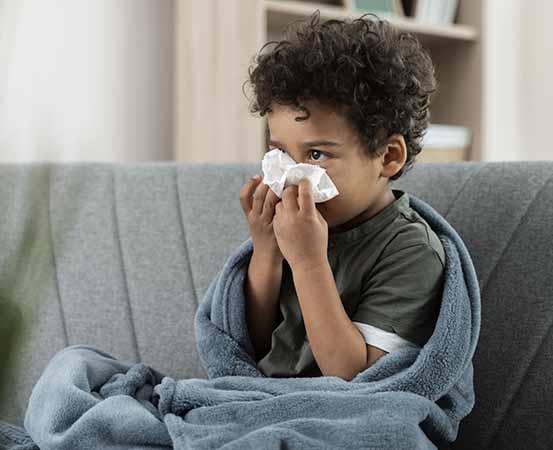
Anusri Shenoy from Mangalore in Karnataka went through a testing time when her seven-month-old son, Avyukth Pai, suddenly started coughing continuously in the middle of the night. What started with a cough progressed rapidly to wheezing, and soon, the baby was struggling to breathe,” said Shenoy. She added that the baby was then treated with oral medication by doctors.
However, concerns grew as the boy experienced a similar episode four months later. The common feature in both episodes was that the boy had tasted a chocolate cream of a cake prior to the symptoms. As another child in the family had allergies, the parents thought that Avyukth might be allergic to chocolate. While an allergy was eventually detected, the boy was further diagnosed with hyperreactive airway disease by his doctor, Dr Kiran N Baliga, pediatrician, KMC Hospital, Mangalore. This condition, also known as reactive airway disease, is characterized by nocturnal cough and breathing difficulty. It can be cured by early interventions, say experts.
What is hyperreactive airway disease?
“Hyperreactive airway disease is a respiratory condition marked by asthma-like breathing problems as an immediate reaction to a specific food. Here, the bronchial tubes, the pathway that brings air into lungs, overreact to any allergen or irritant, causing swelling of the airways. This leads to breathing problems,” explains Dr Baliga. Children who often suffer from cough and breathing difficulties coupled with wheezing are frequently diagnosed with asthmatic triggers, which is different from the common cold.
Dr Indu Khosla, consultant pediatrician, Nanavati Max Super Speciality Hospital, Mumbai, adds that the condition, most often seen in children below the age of five, is caused by lowered immunity.
Why are children vulnerable to hyperreactive airway disease?
Dr Khosla shares that out of 100 people with respiratory ailments, at least 50-60 are children. Of these, at least 50% of the children have hyperreactive respiratory disease. She adds that the condition is seen more frequently after the COVID-19 pandemic.
Dr Khosla explains, “A child under the age of five usually experiences five to six respiratory infections a year, which helps boost immunity. During the pandemic, social interaction was minimized and kids stayed indoors, so they were not exposed to as many substances.”
Dr Baliga opines that along with low or weak immunity, genetics has a role to play. He explains, “If one or both parents have asthma or a history of the same, the chances of children developing this condition is higher.” Avyukth’s was one such case, where his father had asthma in the early childhood years.
Dr Khosla adds that children with a family history of asthma, atopic tendency, or allergy, are more likely to wheeze and cough when they have a viral infection.
What leads to reactive airways in kids?
Most cases of hyperreactive airway disease are triggered by viral infections. The commonest virus is respiratory syncytial virus (RSV), which infects the respiratory tract. The other viruses include metapneumovirus and influenza virus among others, explains Dr Khosla.
Dr Baliga adds that if the condition is seen alongside allergic reactions to a cold breeze, strong odor from deodorant, perfumes, room fresheners, smoke or the smell of firecrackers or fumes, it can trigger the airways, leading to skin and lung reactions.
Watch out for breathing issues from an allergic reaction
Dr Baliga adds, if the child is prone to allergies, there may be skin manifestations in the form of rashes, irritation and eczema (skin dryness and itchiness). Sometimes, they can also have allergic reactions in the nose, and itching in the eyes, adds Dr Khosla. She adds that the child starts breathing faster, and in severe cases, it leads to breathlessness and low oxygen saturation (SPO2 below 95). She explains that children between one to five years of age whose breathing rate is more than 20 per minute must immediately visit a hospital. “These children may need inhalers, oral medicines, or nebulization and in rare cases, the condition requires hospitalization,” she shares.
Avyukth’s mother shares, “My son’s doctor suggested avoiding chocolates or any cocoa-based products, including chocolate health drinks. After he turned six, I started giving him white chocolate first and then gradually gave him tiny bites of chocolate occasionally. Luckily, there was no reaction.”
Hyperreactive airways can be a temporary condition
Reactive airway disease, in most cases, is a temporary condition that can be resolved by building immunity in children, says Dr Baliga. “Only in rare cases of genetic disposition, the condition can persist, increasing the risk of asthma.”
Tips for parents
Experts confirm that parents can take certain steps to manage reactive airways in their children. One must closely observe the child in the early years for any allergic responses, says Dr Baliga. Further, parents must be cautious while introducing complimentary food (any food other than breastmilk) to the child. The two golden tips he suggests are:
- Do not introduce new food at night
- Always introduce one food at a time to a toddler to identify possible irritants or allergens
Further, Dr Khosla explains that those with reactive airways can manage the condition by following certain tips. These include:
- Breastfeed the child for at least a year to help build immunity.
- Avoid crowded places in the early years as these increase the chances of viral infections.
- Avoid early schooling for up to one year to prevent frequent infections.
- Maintain basic hygiene and train the child in hand hygiene.
- Vaccinate the child against influenza.
- Avoid processed food, chocolates, colored food and anything with preservatives as these contain potential allergens.
Takeaways
- Hyperreactive airways are common among children under five years of age.
- Coughing, wheezing, breathing difficulty and skin manifestations are some of the common symptoms.
- Early interventions with immunity building can help.
- In rare cases, it increases the risk of asthma.

















